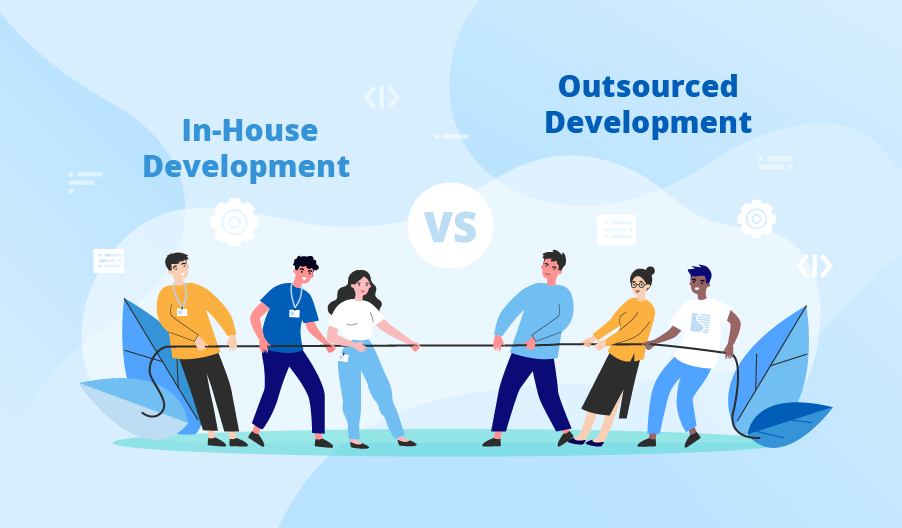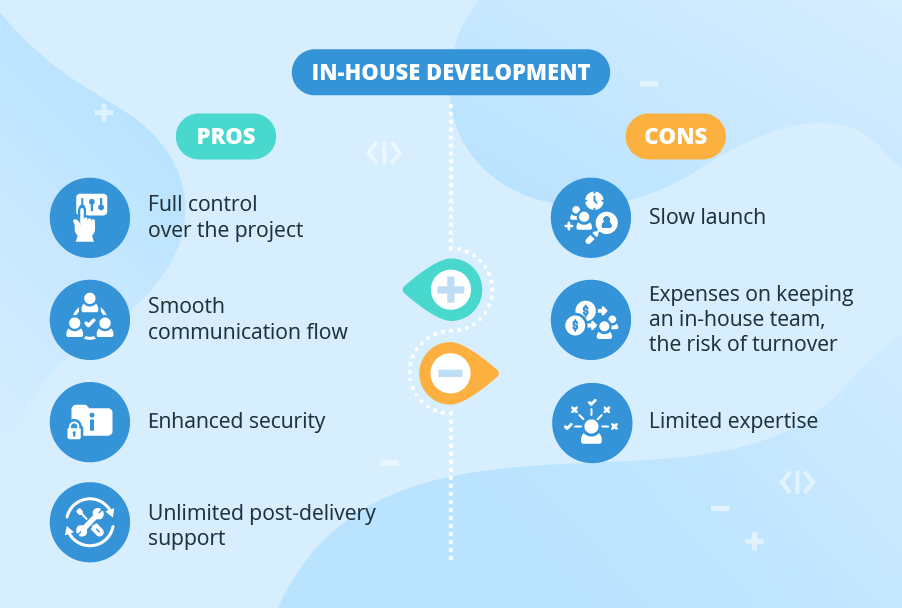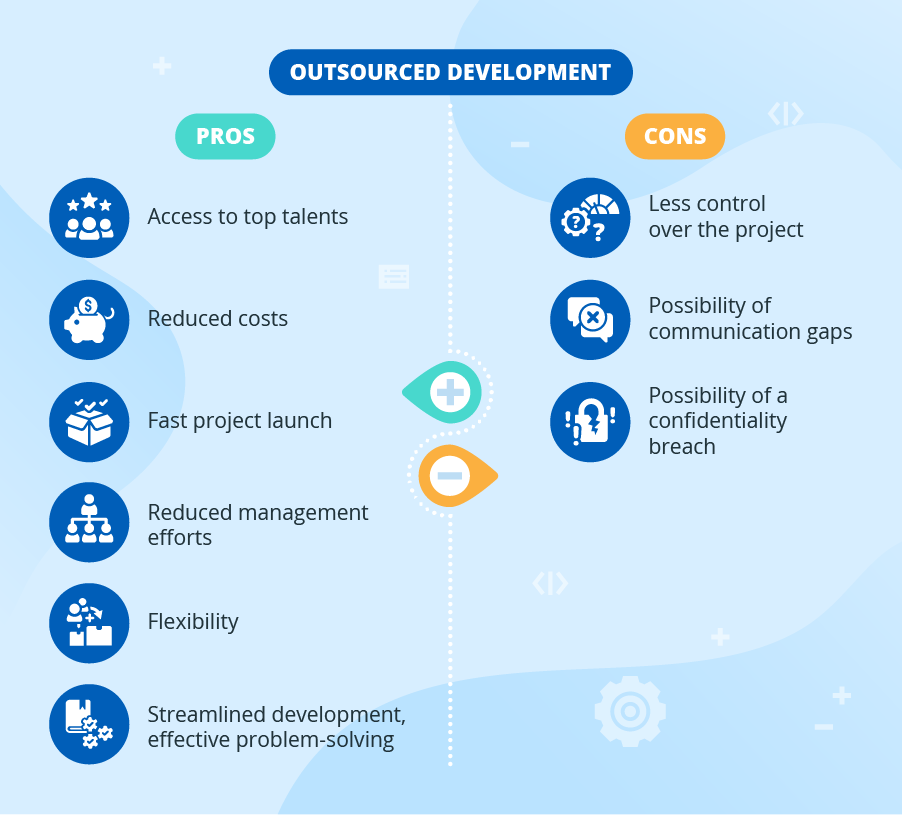In-House Development vs. Outsourcing: Overview of Pros and Cons
Editor’s note: Is building an in-house team for your next development project worth it? Or should you choose to outsource? Won’t it be too risky? Nick discusses both options to help you understand what’s better in your case. If, upon reading, you decide that cooperation with a vendor is what you should look for, feel free to check our software development outsourcing offer.
Whether you’re a startup with an innovative product idea or an enterprise looking for digital transformation, development is a core part of this initiative. As it’s a time- and effort-consuming activity, you may be weighing the viability of in-house development vs. outsourcing.
Let me join this argument and provide some experience-based recommendations. At ScienceSoft, we not only handle outsourced development but also assist in improving in-house development processes. This gives us an insight into the benefits and challenges of both options, which I’d like to share in this article.

In-House Development
Growing an in-house software development team brings increased control over development for you and intense project engagement within the team. You assemble trusted people who have a comprehensive understanding of your corporate culture and business specifics. However, certain conditions have to be observed to make it work:
- Ample time, budget and management resources at your disposal.
- Enough post-delivery work or other projects in the line to employ the team later.

In-house development pros
- Full control over the project. You have visibility over the day-to-day progress, know what your employees are working on, and can react promptly if some stumbling blocks are in the way.
- Smooth communication flow. The same working hours, face-to-face discussions, and the possibility of rapid feedback from the business side result in a shared software vision and faster reaction time of the development team in implementing changes.
- Enhanced security. Your business data and know-how aren’t shared with third parties, and you keep all the knowledge gained during the project inside the company, which minimizes the chance of information leakage.
- Unlimited post-delivery support. Your in-house team stays dedicated to your project after the delivery and is always available for further maintenance, bug fixes, and updates under your request.
In-house development cons
- Slow launch. Hiring one developer takes, on average, 30–35 days, and the task is complicated by high demand for them. You have to compete with other companies and offer better working conditions to attract top talent. And you not only have to think about getting qualified specialists, but also ensure they match each other by skills and personality to be efficient as a team. What’s more, they’ll require time to get familiar with each other’s working styles before reaching high productivity levels.
- Expenses on keeping an in-house team and the risk of turnover. Payroll, taxes, insurance, vacation, training, and maintaining the IT infrastructure are tough on the budget. As per Accelerance, the total cost of in-house developer engagement in the US is roughly $90–$150/hour, with overheads on top of the base rate accounting for around a third of expenses. With that, you don’t have guarantees your employees won’t leave mid-project.
- Limited expertise. Naturally, you can’t gather all the skills and roles in your team. Plus, you may need additional competencies as the project unfolds, for example, to solve arising problems or complex tech tasks. It’ll take longer to get a handle on them with existing resources (and, likely, investments into additional training) and decrease the speed of development. In fact, over 50% of CIOs report that the lack of qualified in-house talents makes it difficult for their companies to grow and compete, pushing them to tap into outsourced skills.
Outsourced Development
A recent survey by Deloitte revealed that 79% of companies opt to fully or partially outsource their development tasks. Today, the primary driver for outsourcing software development is more than just getting the needed competencies right away and cutting costs. Judging by the requests ScienceSoft receives as an outsourced development provider, more and more companies are looking to cover complex development needs with outsourcing, prioritizing managed development as a way to effectively navigate innovations and share risks.
Outsourcing is a good fit for startups without established development and for non-IT enterprises going in for digital transformation, where time and budget don’t favor expanding the IT department with a full-scale development team. Also, outsourcing helps product companies to speed up time-to-market and scale business by increasing development output.

Outsourcing pros
- Access to top talents. You’re not restrained by your geographical location and can tap into the world’s talent pool to find any skills you need, including those in emerging technologies and narrow domains. Moreover, you can select destinations that offer a better price/quality ratio than others. For example, outsourcing development to Poland costs around $50–90/hour – more than twice cheaper than in the US at an equivalent standard of quality. Some other prominent outsourcing destinations are outlined in the article by ScienceSoft’s CTO Boris Shiklo.
- Reduced costs. No expenses related to recruitment, training, retention, payroll taxes, etc., which results in a 1.5–3x lower total cost of outsourced engagement compared to in-house delivery.
- Fast project launch. You get an assembled team whose members are likely to already know how to work with each other from past projects, so you don’t risk getting inner collaboration difficulties and don’t have to spend time hand-picking each employee.
- Reduced management efforts. You get a self-managed team, which frees up your resources to focus on high-level business activities.
- Flexibility. It’s easier to scale an outsourced team up and down depending on your needs. A vendor will take care of adding the right specialists to the team when the project grows and requires more hands to handle.
- Streamlined development and effective problem-solving. You plug into established processes, with many of them already automated and refined according to best practices (e.g., DevOps, CI/CD). Generally, a vendor’s teams have a rich experience in handling development challenges due to a variety of projects they’ve had a chance to participate in. They also have access to the knowledge accumulated inside of their company, which is a great support in case of any problems or non-standard tasks arising.
Outsourcing cons
- Less control over the project. The development process isn’t as transparent as with in-house development, which can put a vendor’s performance in question.
- Possibility of communication gaps. Varying time zones, cultural differences and insufficient English skills may become a barrier to effective collaboration.
- Possibility of a confidentiality breach. Sharing business information may possess some risks stemming from the human factor as well as insecure communication channels.
The presence or absence of outsourcing-related risks depends on a vendor you choose. I recommend avoiding vendors with the lowest prices – this is a very short-term saving that’s likely to bring undesired consequences discussed above. It’s better to focus on getting value-for-money: by choosing a more established vendor, you may pay more (still much less than for an in-house team) but get long-term savings from good quality of their work.
To know how to find a reliable vendor, you can explore another article written by ScienceSoft’s CTO Boris Shiklo.
Summing Up
| In-house development team | Outsourced development team | |
|---|---|---|
| Average developer rate | $90–$150/hour (for the US), can be higher depending on retention expenses | $40–$90/hour (nearshore and offshore developers from low-risk locations) |
| Cost structure | Recruitment, workplace setup, payroll, taxes, insurance, training, vacation, and more | Vendor selection and management, payment for vendor services |
| Hiring | Effort- and time-consuming | Handled by the outsourcing partner |
| Onboarding time | ~4–12 weeks | ~2–4 weeks |
| Expertise | Limited | Vast, including advanced tech competencies |
| Flexibility | Low. Acquiring new competencies invokes hiring and training costs | High. On-demand team reinforcement with the needed skills |
| Management | Full control over the project but substantial management efforts | Reduced management efforts but less control over the project |
| Communication | Smooth and frequent | Depends on the vendor’s approach and developer soft skills |
| Privacy risks | Minimized | Higher risks. Can be mitigated via signing an NDA and an IP rights protection agreement |
| Post-launch support | Smooth, handled by the team that knows the software ins and outs | The vendor may not provide support and maintenance |
So, What to Choose?
The main factors to consider while deciding on in-house vs. outsourced development are the time and budget you have and the complexity of software to be developed.
However, if you want to combine the advantages of both approaches, you can try one of the hybrid strategies:
- Develop an MVP with an outsourced team and then gradually grow your in-house team for further evolution and maintenance.
- In case you already have a development team or an IT department, you can try other models than full outsourcing – a dedicated team or staff augmentation. With these models, you can keep core development activities in-house, while benefiting from outsourcing routine or, on the contrary, narrow areas of development.
If you decide to leverage outsourcing benefits either with full outsourcing or a hybrid strategy, our team at ScienceSoft is ready to help, just let us know.

